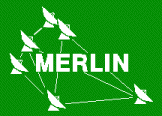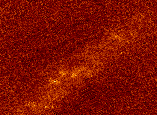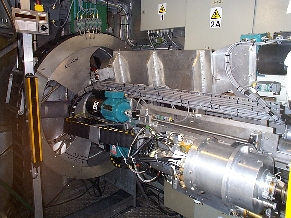 |
MERLIN/VLBI National Facility Newsletter |
 |
This is the first of a regular biannual newsletter that will describe
activities at the MERLIN/VLBI National Facility (NF). In the past there has
been no clear mechanism for disseminating information to the NF's user
community; this is being rectified through this newsletter and also through
the publication of a more detailed biennial report. Copies of the first
edition of this report, covering the period 1997-1998, were made available
at NAM and will be distributed further within the next two weeks.
Call for Proposals
There are two proposal deadlines approaching that are relevant to the NF.
The first is the deadline for Semester 00A on MERLIN. Note that the
MERLIN deadline is non-standard and after the busy time of October 1, this
is possible because the NF staff process the proposals for the PPARC
secretariat.
The proposal deadline is 9th October 1999. All details are in the
MERLIN web area, specifically:
http://www.merlin.ac.uk/schedules/index.html
MERLIN will be offering 22GHz, 5GHz, and 1.4-1.7GHz for Semester 00A
(although it is not yet clear if the Lovell telescope will be available for 1.4-1.7GHz in 00A).
Proposal forms, information on MERLIN Key Programmes, and further
general information can be obtained via:
The second is the autumn deadline for European and global VLBI:
The proposal deadline is 1st October
1999. All details may be found in the EVN USERS GUIDE at:
http://www.nfra.nl/jive/evn/evn.html
The provisional plan for EVN observing sessions in 2000 is given below,
proposals received by October 1st will be considered for scheduling
in any of the sessions listed.
| 2000
| Session 1
| Feb 10 - Mar 02
| 6 cm,
| (+MERLIN),
| 18/21 cm, + ?? |
| 2000
| Session 2
| May 25 - Jun 15
| 6 cm, |
| 18/21 cm, + ?? |
| 2000
| Session 3
| Sep 06 - Sep 27
| 6 cm, |
| 18/21 cm, + ?? |
| 2000
| Session 4
| Nov 08 - Nov 25
| 6 cm, |
| 18/21 cm, + ?? |
The ?? signify wavelengths to be allocated based on proposal pressure.
General News
At the time of writing PPARC have not yet notified us
of our final budget for the next grant period. As some of you may be
aware there is worry on that front since the rate of salary increases is
greater than the inflation indexation rate applied to all PPARC grants. This,
combined with the lack of inflationary increases for the NF grant in the past
means that the operational, non-staff costs for the NF are under
severe pressure. At the June meeting of the GBFC the NF's problems were
recognized and a short-term financial band-aid was promised which may help
the situation. However in the longer term other measures are needed and GBFC
decided that the NF operation should be reviewed next summer in order to
evaluate the efficiencies resulting from the restructuring programme initiated
two years ago and determine a new base budget for continued operation and
development.
There is some good news: GBFC allowed the NF to appoint a data archivist
whose job is to produce an archive of all MERLIN data. This will be accomplished
in three phases: first the archive database and web interface will be created;
secondly, an existing pipeline reduction script written in AIPS will be
used to start populating the database with calibrated data and initial images
from new observations; finally the archivist will move backwards through the
existing archive of raw data and produce a full archive. The existing rules
regarding open access to MERLIN data will remain in place, that is: MERLIN data
becomes publicly available 12 months after the end of the semester in which the
observations were made. Dr. Anita Richards has been appointed as the archivist
from October 1, 1999.
In addition, we welcome Brian Smith to Jodrell Bank. Bryan joins us on an
EU funded programme to perform development work on broadband fibre optic
connections. Specifically, he is modelling the transmission characteristics
of such fibres and assessing the feasibility of transmitting several Gbit/sec
over lengths of 100s and 1000s of km.
Recent Science: Supernova Remnants and HII regions in NGC2146
NGC2146 is a starburst galaxy at a distance of 14.5 Mpc. The nuclear
region is highly obscured in the optical, but radio observations with
the VLA (Glendenning & Kronberg 1986, BAAS 18, 1006) revealed a
populations of about 20 point sources which were interpreted as radio
supernovae (RSN) or supernovae remnants (SNR). MERLIN + VLA observations
at 5 GHz with 150 mas resolution show that 7 of the sources are resolved
in to diffuse structures, some of which have shell-like morphologies.

NGC2146
(Click on image for full
version)
|
Additional 1.4 and 1.6 GHz MERLIN data have shown 9 sources coincident in
position with the ones detected at 5 GHz and allowed us to compute their
spectral indices. Three of them show values consistent with synchrotron
emission from SNR or RSN, but the others present a very steep inverted
spectrum. Most of the sources with inverted spectrum are unresolved with
diameters < 9 pc and TB > 1000 K, but two are resolved in amorphous
structures with sizes 10 and 20 pc. We claim that the positive spectral
index sources are optically thick compact or "ultra dense" HII regions
with ne > 103 cm-3, ionized by
103 O6 equivalent stars.
|
Such massive regions of current star-formation have been seen in other
galaxies (NGC5253 and Henize 2-10), but, interestingly, are not seen in
M82; this last galaxy has in fact many similarities with NGC2146. The
present starburst in NGG2146 may lie in a temporally intermediate phase
between the very young ones such as in NGC5253 and older examples like
M82 (the ageing of the bursts refers to the sequence presented in
Rieke et al., 1988, ApJ 325, 679).
The inverted spectra could alternatively be caused by strong free-free
absorption at 18cm caused by foregroung ionized gas with very high
emission measures (> 108 pc cm-6). The MERLIN
observations also reveal a very compact steep-spectrum source close to
the centre of the galaxy which is, up to now, considered a candidate
for a RSN, because of its steep nonthermal spectrum and its high
brightness temperature. HI absorption has been detected against this
source using MERLIN at 21cm, implying a column depth of 25 x 1021
cm-2.
These observations demonstrate the current ability of MERLIN to
resolve SNR and star-forming regions in increasingly distant galaxies.
The proposed upgrade for MERLIN, including the resurfaced Lovell
Telescope, will allow populations of SNR and HII regions to be studied
in many more galaxies at greater distances.
PI: A. Tarchi (Bonn), Co-I's: N. Neininger, U. Klein (Bonn),
A. Greve (IRAM), B. Glendenning (NRAO), A. Pedlar (JBO), S. Garrington,
T. Muxlow (MERLIN/VLBI NF).
Summer Engineering Work
The so-called "shutdown" of the National Facility for about three months
each summer is, in fact, the busiest time of the year for the professional
engineering staff who operate the system. With the telescopes in 24-hour
operation throughout the rest of the year, this is the only opportunity to
undertake much of the essential maintenance and to implement many of the
developments required by our policy of continuous improvement in the
quality of the science output.

MkII Multiple Receiver System
(Click on image for larger
version)
|
Our main task this summer has been the complete replacement of the servo,
drive and control system on the Darnhall telescope which is one of the 25-m
diameter VLA-style dishes located about 30km from Jodrell Bank. This is part
of the Restructuring initiative, which also provides for similar work to be
carried out on the Knockin and Pickmere telescopes in summer 2000. The
existing (original) control systems on these three telescopes are more than
20 years old, obsolete and beginning to cause trouble, so the replacement is
timely. It is interesting to note that even electric motor technology has
advanced since the telescopes were built, with the result that the new
motors are substantially smaller than the originals.
At the time of writing, the new hardware is installed and commissioning is
almost complete. The revised telescope control software has also been
written and installed. Testing of the complete system is due to begin
shortly.
Also ready for testing is a new version of the Mk2 telescope control
software which will permit full remote control of the receiver changing
carousel in the focus cabin during the next 5/22GHz observing session
early in the new year. However, final commissioning of this system has
been deferred until after the September VLBI session to permit completion
of improvements to the elevation drive and new focus access arrangements
required by the Health & Safety Executive. The construction of the carousel
was a direct scientific benefit of the restructuring programme which was
otherwise aimed at decreasing the running costs of current observations.
It was designed and commissioned in-house in less than 12 months.
|
The Lovell Telescope, which is an important element of many National
Facility observations, has been the subject of major engineering work this
summer, including:
- trials of a technique to renew the reflecting surface
- painting of the reflector backing structure
- repairs to the azimuth track
- replacement of critical bearings in all four azimuth drive bogies.
The University has made a bid to the Joint Infrastructure Fund for a grant
to renew the whole of the reflecting surface using the technique
successfully tested this summer. If the bid is successful, we plan to
complete the work in two, extended summer maintenance periods.
The bearings we have replaced were installed when the Telescope was first
constructed in the early 1950s. We hope that the new ones last equally
well.
MERLIN: A Vision for the Future
As you will read in the biennial report mentioned above we have
a plan for the future development of MERLIN which will, when completed,
transform MERLIN into a new instrument with more than an order of magnitude
improvement over the current sensitivity and three times the current
resolution for high quality imaging. This transformation is especially
relevant as we enter a new era of high resolution astronomy, with infrared
adaptive optics already demonstrated on GEMINI and with NGST and ALMA on the
horizon, MERLIN is uniquely placed to provide complementary radio observations.
The development plan for MERLIN capitalizes on this position.
The plan is discussed in more detail at
http://www.merlin.ac.uk/newsletter/archive/future.html
Briefly, the development is envisaged in three stages:
- Array Upgrade: new 12-15 GHz receivers, full frequency flexibility,
replacement of the Defford telescope
- Prototype Fibre Link: development and testing of a broad-band fibre
link between Jodrell Bank and Cambridge
- Array broad-banding: the linking of all telescopes to Jodrell Bank
with optical fibres and the installation of a new broad-band correlator
Along with the concurrent resurfacing of the Lovell telescope, these
upgrades will provide, without significant increase in running costs,
a 25-fold sensitivity increase at the prime
operating frequency of 5 GHz with 50 mas resolution and the ability to
carry out reliable imaging at 22-24 GHz with 8 mas resolution.
The exact sequencing of the components of the development is not
critical, nor is the division into three stages.
The unique combination of resolution, sensitivity and frequency
coverage of an upgraded MERLIN will open up a spectacular range of new
possibilities in both galactic and extra-galactic astronomy. In
particular it will bring within reach the thermal and ionized universe
of stars, nebulae and active galaxies in a wavelength regime
unobscured by dust. Stellar astronomy in particular will be
revolutionised by the ability to detect thermal emission from warm gas
and dust with linear resolution of a few AU or better. MERLIN will
therefore provide complementary science to ALMA (which studies
cold/cool material at somewhat lower resolution) and NGST. Other
MERLIN opportunities include fundamental astrometry with a positional
accuracy < 0.1 mas; planetary searches; studies of star forming
regions and active stars; methanol and excited state OH masers,
extragalactic SNR and starburst galaxies, AGN and a wide range of
cosmological studies.
Subscription to the MERLIN mailing list
To subscribe to the electronic mailing list for the MERLIN/VLBI National
Facility send an email to
Majordomo@jb.man.ac.uk with the following command in the body of the
email message (not the Subject field);
subscribe merlin-announce
If you ever want to remove yourself from the MERLIN mailing list,
send an email to Majordomo@jb.man.ac.uk
with the following command in the body of the email message;
unsubscribe merlin-announce
or from another account, besides the one used to subscribe to the
list,
unsubscribe merlin-announce your-email-address
If you ever need to get in contact with the owner of the list,
(if you have trouble unsubscribing, or have questions about the
list itself) send email to
owner-merlin-announce@jb.man.ac.uk.
MERLIN/VLBI National Facility, Jodrell Bank Observatory, University of Manchester,
Macclesfield, Cheshire SK11 9DL, United Kingdom
Telephone: +44 (0)1477 571321, Facsimile: +44 (0)1477 571618



